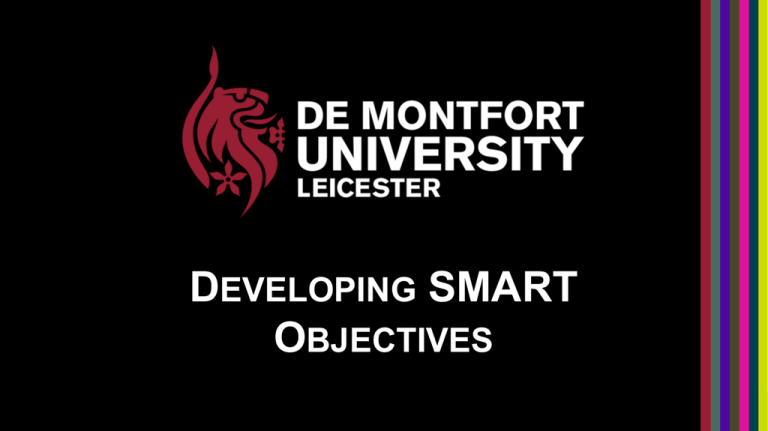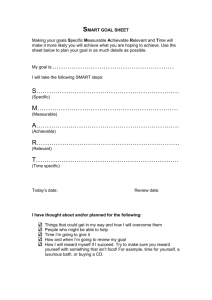DEVELOPING SMART OBJECTIVES
advertisement

DEVELOPING SMART OBJECTIVES WHAT IS A WORK RELATED OBJECTIVE? It is….. It isn’t…… • • A list of activities or responsibilities of the staff member/appraisee’s role • The same as a goal • A mutually understood agreement about a specific work outcome that a staff member/appraisee is expected to achieve within the Appraisal Cycle Linked to faculty/department/ organisational strategic goals SMART PRINCIPLES • Specific: It states what the appraisee will do. This must be clear and well defined • Measurable: How will you know when the outcome is achieved? What does success looks like? • Achievable: Is it realistic? It should be stretching but not impossible • Relevant: Linking to the job role and the aims of the faculty • Time Bound: Supports planning and monitoring progress. Again should be specific BENEFITS FOR THE APPRAISEE • Provides the opportunity to state how and what work is undertaken, to raise ideas and concerns over what will be accomplished • Clarifies priorities and supports planning of workloads • Provides a clear understanding of how work will be measured, allowing individuals to assess their success • Opportunity for Appraisees to ensure their personal development needs can be met through work objectives. BENEFITS FOR THE APPRAISER • Jointly agreed objectives support ownership and understanding of work to be achieved • Ensures individual objectives link to team/faculty objectives • Information can be used for planning purposes EXAMPLES OF NON-SMART OBJECTIVES • ‘Increase methods of teaching materials for students’ • ‘Lead the faculty’ • ‘Improve student employability’ • ‘Email contact details to all faculty managers by 1st October’ • ‘Be more receptive to student feedback’ • ‘To continue working as well as I do now’ EXAMPLES OF SMART OBJECTIVES 1. Develop and implement on-line lectures for two teaching modules by January 2014 • Specific – • Measurable – • Have the capacity and resources to achieve 2 out of 6 modules Relevant – • 2 Teaching Modules Achievable – • It says what the staff member will do – “develop and implement on-line lectures” Supports key aims for faculty to increase access points for student experience Time Bound – To be achieved by January 2014 EXAMPLES OF SMART OBJECTIVES 2. Develop 1 additional assessment method for two student assignments by March 2014 • Specific – • Measurable – • Have sufficient resources and capacity to complete Relevant – • 1 new method for two assignments Achievable – • It says what the staff member will do – “develop additional assessment methods” Faculty undertaking project to develop ‘Inclusive Assessment Processes’ Time Bound – By March 2014 EXAMPLES OF SMART OBJECTIVES 3. Network with Academic staff in Faculty ‘X’ to collaborate on research for publication by May 2014 • Specific – • Measurable – • Capacity, resources agreed Relevant – • Partnership created, Research published Achievable – • Working in partnership with academics in another faculty for undertaking research Important area of research for the faculty and of national interest. (Supports the organisation) Time Bound – By May 2014 PREPARING TO WRITE SMART OBJECTIVES • Read your faculty strategic and/or operational plan • Speak to your line manager appraiser about the key priorities for the next 12 months • Think about how your continued development can also support the development of the faculty and organisation • Consider acceptable levels of performance when determining measures of success

